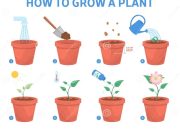Types of Rectangular Outdoor Plant Pots

Rectangle plant pot outdoor – The selection of a rectangular outdoor plant pot involves careful consideration of material, drainage, and aesthetic design to ensure both the plant’s well-being and the enhancement of your outdoor space. The diverse options available cater to various styles and practical needs, allowing for a personalized touch in landscaping.
Materials Used for Rectangular Outdoor Plant Pots
Rectangular outdoor planters are crafted from a variety of materials, each offering unique advantages and disadvantages concerning durability, weather resistance, and aesthetic appeal. Ceramic pots, for instance, provide an elegant and classic look, but are susceptible to cracking under extreme temperature fluctuations or impact. Concrete pots, on the other hand, boast exceptional durability and weather resistance, making them ideal for harsh climates.
However, their weight can pose challenges during movement or installation. Plastic pots offer affordability and lightweight portability, but their longevity and aesthetic appeal may be less impressive than other options. Wooden planters, often constructed from treated lumber or cedar, bring a rustic charm, but require regular maintenance to prevent rot and insect damage. Finally, metal planters, such as those made from galvanized steel or aluminum, provide a modern and sleek aesthetic, though they can be prone to rust or corrosion without proper treatment.
Drainage Systems in Rectangular Outdoor Planters
Effective drainage is crucial for preventing root rot and ensuring the healthy growth of plants. Many rectangular planters incorporate drainage holes in their base, allowing excess water to escape. However, the effectiveness of this system depends on the planter’s material and the surrounding soil conditions. For example, a ceramic pot with ample drainage holes placed on a well-draining surface will perform well.
Conversely, a plastic pot with insufficient drainage holes sitting on compacted soil may lead to waterlogging. Some advanced drainage systems include internal drainage layers or reservoirs that allow for controlled watering. Ineffective drainage solutions, such as solid-bottomed planters without drainage holes, can quickly lead to root problems and plant death. Choosing a planter with appropriate drainage for the specific plant and its environment is essential.
Design Variations in Rectangular Outdoor Planters
Rectangular outdoor planters exhibit a wide range of design variations, encompassing size, shape, and stylistic features. Sizes range from small window boxes to large trough planters, accommodating various plant types and landscaping schemes. Shapes can be strictly rectangular or incorporate subtle curves and variations in height, adding visual interest. Stylistic features vary widely, from minimalist designs characterized by clean lines and simple forms to rustic styles featuring weathered wood or distressed metal finishes.
Modern planters often showcase sleek materials and geometric shapes, while traditional styles may incorporate ornate detailing or classic materials.
Hey there, fellow plant lovers! Looking for a stylish rectangle plant pot for your outdoor space? To keep those beauties happy and hydrated, even when you’re busy, check out these amazing self watering plant pots – they’re a lifesaver! Imagine your rectangle pots looking lush and vibrant, all thanks to clever watering solutions. So, get potting!
| Material | Size Range (cm) | Drainage Type | Style |
|---|---|---|---|
| Ceramic | 20-100+ | Drainage holes | Classic, Elegant |
| Concrete | 30-150+ | Drainage holes, internal reservoir | Modern, Rustic |
| Plastic | 15-80 | Drainage holes | Contemporary, Budget-friendly |
| Wood | 25-120+ | Drainage holes, raised base | Rustic, Traditional |
| Metal (Steel) | 20-100+ | Drainage holes | Modern, Minimalist |
Aesthetic Considerations and Design Inspiration: Rectangle Plant Pot Outdoor

The strategic placement and careful selection of rectangular planters significantly impact the overall aesthetic of an outdoor space. The interplay of materials, styles, and the surrounding landscape creates a harmonious and visually appealing environment. Understanding these elements allows for the creation of unique and captivating outdoor designs.
Three Outdoor Spaces Incorporating Rectangular Planters
The following examples demonstrate how rectangular planters, in diverse materials and styles, can transform different outdoor settings.
Space 1: Modern Minimalist Courtyard
This space features sleek, concrete rectangular planters in a neutral grey. The clean lines of the planters complement the minimalist architecture of the courtyard, which includes smooth, light-colored walls and sparse, carefully chosen plantings. The planters are strategically placed to frame a small, tranquil water feature, creating a focal point. The overall aesthetic is one of serene simplicity and modern elegance.
The choice of concrete reflects the minimalist aesthetic, providing a durable and understated presence that does not compete with the architectural elements.
Space 2: Traditional English Garden
Here, terracotta rectangular planters, varying in size and exhibiting a slightly rustic finish, are used. They are filled with a mix of colorful flowering plants and herbs, echoing the abundance and vibrancy of a traditional English garden. These planters are placed along a winding path, interspersed with flowering shrubs and climbing roses. The overall aesthetic is one of romantic charm and timeless elegance.
The terracotta complements the natural earth tones of the garden, creating a cohesive and inviting atmosphere.
Space 3: Tropical Balinese Oasis
This space showcases large, dark wood rectangular planters, featuring intricate carvings inspired by Balinese art. These planters are filled with lush tropical plants, such as orchids and ferns, enhancing the exotic atmosphere. The planters are strategically positioned around a shaded seating area, providing a sense of enclosure and privacy. The overall aesthetic is one of lush opulence and exotic tranquility.
The dark wood planters, with their detailed carvings, create a striking contrast against the vibrant greenery, adding a touch of artistic sophistication.
Rectangular Planter with Integrated Lighting, Rectangle plant pot outdoor
Imagine a long, low rectangular planter crafted from polished dark grey granite. This planter is subtly illuminated from within by a series of energy-efficient LED strip lights positioned along its bottom edge. The soft, warm white light casts a gentle glow upwards, highlighting the texture of the granite and subtly illuminating the plants within. The overall effect is one of understated elegance and sophistication, creating a welcoming ambiance, particularly in the evening.
The granite’s durability ensures longevity, while the LED lighting provides a sustainable and visually appealing feature.
Rectangular Planters in Different Landscaping Styles
Rectangular planters offer versatility across diverse landscaping styles.
Contemporary Landscaping: In contemporary gardens, sleek, minimalist rectangular planters made of materials like concrete, steel, or composite materials are often used. They typically feature clean lines and neutral colors, complementing the modern architectural style. For example, a series of identical, rectangular concrete planters could be arranged symmetrically along a patio to create a visually striking and modern landscape.
Traditional Landscaping: Traditional landscaping styles often incorporate rectangular planters made of materials such as terracotta, stone, or wood. These planters may have more ornate detailing or a rustic finish, reflecting the classic and established nature of the style. A row of terracotta planters filled with classic English roses would enhance the charm of a traditional cottage garden.
Mediterranean Landscaping: Mediterranean landscaping frequently utilizes rectangular planters made from materials like clay, stone, or even reclaimed wood. These planters often feature warm earth tones and are filled with drought-tolerant plants, reflecting the dry climate of the region. Imagine a collection of whitewashed clay planters, overflowing with lavender and rosemary, creating a fragrant and visually appealing Mediterranean corner.
Query Resolution
What is the best material for a rectangular outdoor planter in a very sunny location?
Terracotta or ceramic planters are porous and can help prevent overheating, but they may require more frequent watering. Consider a darker colored plastic or metal planter for better heat reflection.
How do I prevent my rectangular planter from cracking in freezing temperatures?
For frost-prone areas, use frost-resistant materials like durable plastics or metal. For ceramic or terracotta pots, consider bringing them indoors during extreme cold or using insulating materials around the base.
How often should I water plants in rectangular outdoor pots?
Watering frequency depends on factors like plant type, pot size, material, weather, and soil type. Check the soil moisture regularly; water when the top inch feels dry.
Can I use rectangular planters for vertical gardening?
Absolutely! Tall, narrow rectangular planters are perfect for vertical gardening, maximizing space and creating visually striking displays.












